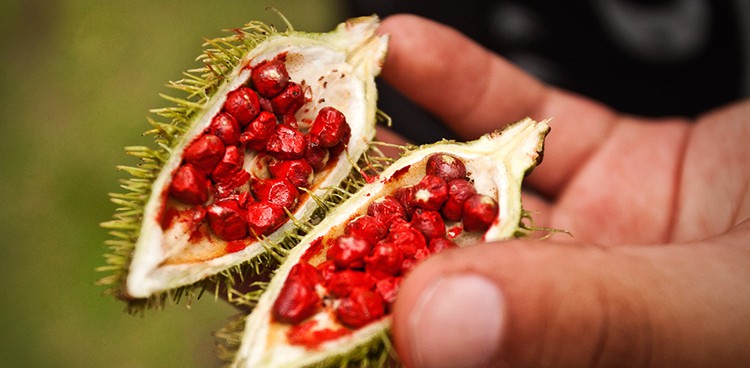
What do French Mimolette, British Red Leicester, and certain Wisconsin cheddars have in common? Besides being cheese, that is.
Different as they are, all these cheeses have a deep orange hue. And all share the same coloring agent: annatto, a tropical plant whose seeds have been used to color everything from Aztec paintings to cosmetics and food.
Some 17th-century British producers began using annatto to improve the appearance of pale, late-season cheeses made from milk that was low in beta carotene. “The [nutrients] in the Cheshire soil produced a deeper hue in the milk of the cows that grazed those pastures, and [as a result] the cheese fetched a premium over the cheddars and Wensleydales,” explains author Steve Jenkins, specialty food buyer at New York City’s Fairway Market. “Those other producers wanted their cheeses to have the same tint, and they got that from the annatto seed.”
This didn’t impress the Cheshire cheesemakers, however.
“They agreed in Cheshire that any cheese that was colored would have to use a lot of coloring to make it glaringly obvious that it was colored,” says Ari Weinzweig of Ann Arbor, Michigan–based Zingerman’s. “Their assumption was people wouldn’t be interested, but those turned out to be the cheeses people seemed to want more.”
Ever since, annatto extract has been added to milk in quantities according to the desired effect. “To make a really dark cheddar, it would be about 2½ ounces of annatto per 1,000 pounds of milk,” says Joe Widmer, master cheesemaker and owner of Wisconsin- based Widmer’s Cheese Cellars. But he also uses it, as do many other cheesemakers, to lightly tint other cheeses. “For brick [cheese], we use ½ ounce per 1,000 pounds of milk, which just turns the cheese yellow instead of bright orange.”
Does annatto guarantee appeal? It depends.
“In the Midwest you must have orange cheddar. That’s how people know and expect it,” says Liz Thorpe, vice president of Murray’s Cheese in New York. “Here, there’s the perception that orange cheddar might be more mass-produced and milder in flavor, while white cheddar is superior. But one is no better or worse than the other.” On the other hand, Thorpe notes, “Nobody makes a color judgment about some cheeses, such as Mimolette.”
“Appearance is a crucial part of a cheese’s identity,” explains Bronwen Percival, a buyer for Neal’s Yard Dairy in London. “Certain cheeses are always colored (Red Leicester springs to mind), whereas others, like Cheshire, can be orange or white. In the UK, orange coloring does not have the same industrial associations it does in the U.S. But it would be unusual to see an orange cheddar, even if it were produced on a large scale in a factory.”
Annatto enhances color—but does it affect flavor, too? “Some people think there’s a difference,” Widmer says, “but it’s impossible for anyone to taste anything in 1,000 lbs. of milk.”
Thorpe concurs. “I’ve done zillions of blind taste tests, and I couldn’t tell whether a cheese was colored.”
The bottom line? “Annatto just makes cheese pretty,” Jenkins says.
Besides, Widmer quips, “It would be boring if you went to a party and all the cheese was white.”
Feature Photo Credit: Fotos593 | Shutterstock



